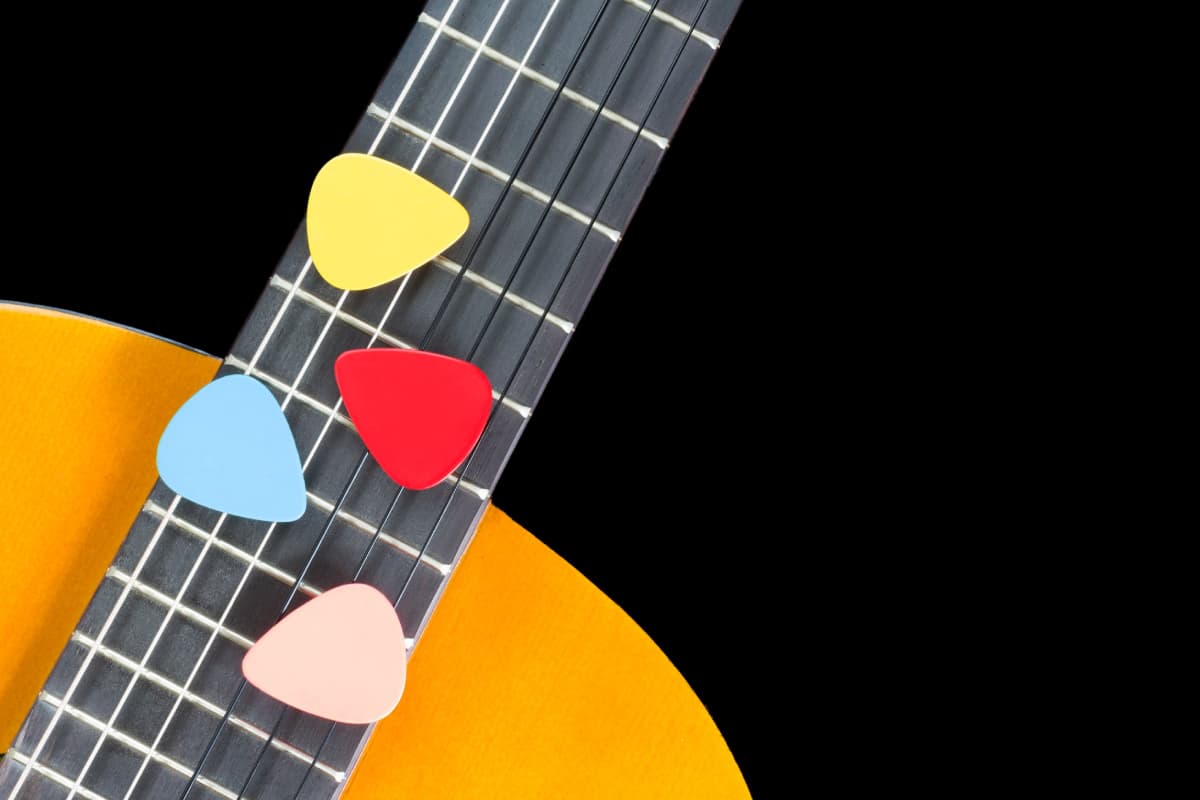When first learning how to play the guitar, there are two strumming methods that you can try: fingerstyle, where you play with the pads of your fingers, and using a pick. Guitar teachers have long debated the question of which way is better, which begs the question: Should beginner guitar players use a pick?
Beginner guitar players should use a pick when learning to play guitar. Using a pick will significantly impact the guitar’s sound, enhance the guitar’s playability, and increase flexibility. Beginners also learn to play their instrument more efficiently with a pick than with fingerstyle.
This article will go into each of these facts a bit deeper and will explore why starting out playing guitar with a pick is the best option. Please read on if you want to know more about how using a pick can benefit beginner guitar players.
👇😀👇NOTE👇😀👇
If you want to find out what my recommended guitar gear is, then here is what I recommend on Amazon:
- Fender Cutaway Acoustic-Electric Guitar Bundle (MY FAVORITE GUITAR)
- Snark SN-8 Super Tight All Instrument Tuner (Easiest Tuner I’ve Used😏)
- 6 String Acoustic Guitar Capo (Best CAPO for quick changes)
- Dunlop Max Grip 1.0mm Nylon Picks (Thick Guitar Pick So You Don’t Lose Grip!)
- Universal Guitar Stand (Cheap & Minimalist Guitar Stand I Recommend)
- Levy’s 2″ Wide Quick Adjust Guitar Strap (Best Guitar Strap For Any Level)
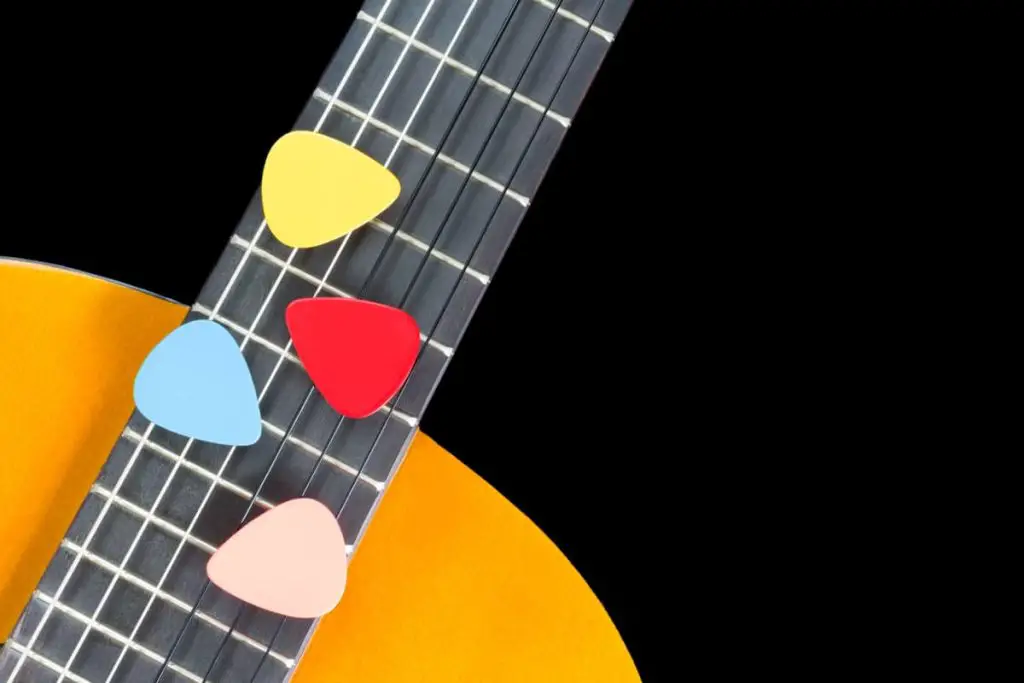
Facts About Using a Pick as a Beginner Guitar Player
Many guitar teachers believe that the main deciding factor in whether someone turns into an experienced, talented guitar player or not is how hard they find the instrument at the start.
If you start playing guitar and have some success with it from the beginning, you are much more likely to feel confident in your abilities, and you are likely to stick with it. One of the best ways you can succeed as a beginner guitar player is by using a pick to play or “flatpicking.”
You will find many good reasons to use a pick when you consider the benefits of flatpicking instead of fingerplay. Here are seven facts about why using a pick as a beginner guitar player is an intelligent decision.
1. Picks Have an Impact on the Guitar’s Sound
As a beginner, getting the hang of maneuvering a pick over the strings may initially seem challenging. You may even prefer to try using the side of your thumb or index finger just to see if it makes a difference.
Truthfully, you will have a more challenging time creating a good consistent sound when you’re strumming with your finger or nail than when you’re flatpicking. The plectrum makes a more consistent tone due to the consistency of the material, while different parts of your fingers produce different sounds.
You’ll want to hear the sounds you are creating when you’re first starting your playing so that you can understand how each technique works. You’ll have much more difficulty doing that if you use your hands.
Flatpicking will produce a much louder, more unmistakable tone than your fingers. Hearing the chords you are playing is vital when you are first beginning, and a pick will be ideal for that since your fingers will not be able to strike the strings as clearly.
2. How You Hold the Pick Makes a Big Difference
One of the biggest reasons beginner guitarists shy away from using picks is that they have trouble holding them steady while they are learning to play and don’t like the sound that comes off the guitar. However, if you know how to hold the pick from the get-go properly, it will be obvious why flatpicking is the best choice for a new guitarist.
When you take the pick in your hand, hold it between your thumb and index finger. You’ll need to be sure to grasp the pick firmly, keeping your thumb clamped down on top of it while it sits on the top side of your index finger.
As long as you can keep a tight grip on the pick as you strum, you’ll find that using one is much more enjoyable than playing with just your fingers.
The amount of pick left sticking out from your thumb, and index finger will depend on what type of playing you want to do. If you’re strumming all six strings at once, you’ll want to leave a good portion of the pick exposed so it can accurately hit all strings.
If you are going to be picking individual strings, you’ll only want a small bit of the pick sticking out between your fingers.
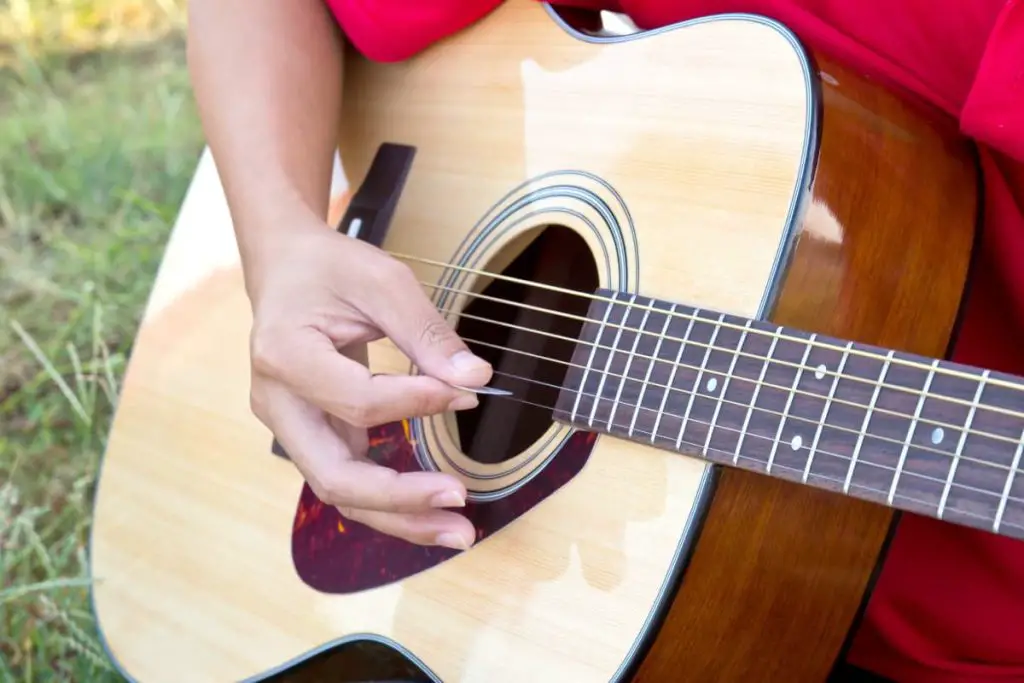
3. Picks Will Enhance the Playability of the Guitar
One of the main reasons to choose flatpicking as a beginner is so you can clearly hear the sounds you’re creating and adjust your playing accordingly. Because your music is easier to hear, your guitar will also be easier to play when you’re using a pick.
Picks are designed explicitly with string plucking and strumming, so they will inevitably be easier for a beginner to master than fingerstyle. Your fingers have a less than ideal shape to pluck at strings, so until you have mastered the art of doing so, it will be much more challenging than just playing with a pick.
The pick making your guitar more playable is especially true when it comes to steel strings. Unless you are learning classical guitar, your instrument likely has solid steel strings, which will be very difficult to play using only your fingers, particularly as a beginner.
This type of string can be harsh on your fingertips if you’re not used to it, and you may experience some pain after only one playing session without a pick. The desire to be comfortable while playing is a good enough reason to adopt flatpicking from the beginning!
3. Picks Will Enhance the Playability of the Guitar
When learning to play guitar, you must be as meticulous as you can with your training. You need to be able to hit the individual strings just the right way to create the sound you are hoping to achieve, and that can be pretty challenging to do with your fingers.
Using a pick to precisely hit every single string on the guitar can be a tremendous help, mainly when you’re just figuring out what picking technique you prefer.
When flatpicking, you can be more agile with your playing, like focusing on one specific note or melodic passage to nail down. It will help you learn to isolate the chords and hit the strings precisely how you intend to, instead of fumbling through the notes with your fingers.
5. Picks Help You Learn Proper Strumming Techniques
When you start out learning guitar, flatpicking will teach you how to strum your instrument the correct way. You’ll not want to leave your hand resting on the guitar as you might with fingerstyle because you will produce a much brighter and bolder sound with your hand placed in the air just above the sound hole.
Keeping your arm out of the equation is essential as well. You’ll need to rotate your wrist just a bit to get the correct motion with the pick. It may seem challenging to keep your wrist straight and slightly rotate it simultaneously, but once you begin hitting the strings, it will all come together and make sense.
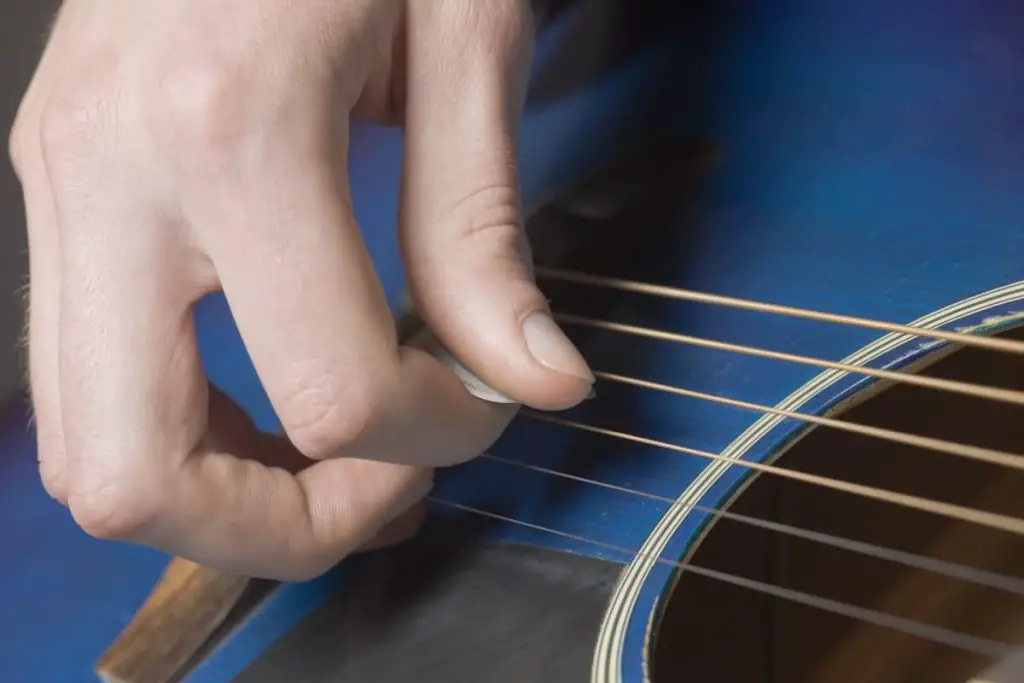
6. What Is Easiest First Is Not Always Best
Even using all of the advice above, trying to keep control of a pick while first learning to play guitar can be stressful and overwhelming. However, just because you have a tough time working with the pick at the start doesn’t mean your music will turn out much better if you automatically switch to your fingers.
Learning guitar is no easy feat; it will take endless time and practice to get the hang of the instrument. That being said, don’t decide between flatpicking or your fingers based on avoiding the seemingly more difficult option.
As long as you commit to implementing the pick into your playing and practicing with it regularly, it will become easier with time, and you will likely enjoy working with it.
7. Starting With a Pick Doesn’t Mean You Can’t Change Over
Many new musicians tend to have an all-or-nothing attitude about how they learn their instrument. This stubbornness can undoubtedly factor into whether or not you choose flatpicking as a beginning guitar player.
It’s important to remember that just because you started flatpicking doesn’t mean you have to play that way for the rest of your life. You can always decide to change your tactic once you have more experience with your guitar.
Starting with a pick can be very helpful because if you enjoy how it feels, you may decide you don’t even want to try to learn another method of strumming. Coming to that conclusion is completely fine, and because you’ll already have the experience, it will come much more naturally to you.
If you do think you want to learn fingerstyle, the good news is you’ll already understand how you should be using your hand to strum. All you have to do then is translate the muscle memory of flatpicking into your fingertips, and you’ll find that fingerstyle comes naturally.
Beginner Guitar Players and Flatpicking
Based on the above facts, it’s clear that flatpicking will be crucial for people just learning the guitar. What exactly makes someone a beginner at the instrument, though, and how do you know when you have passed the threshold into intermediate playing?
A few attributes separate a new guitar player from a mid-tier one, and these factors will make a difference in who should be playing with a pick and who might be ready for more advanced practices.
However, beginners should keep these considerations in mind when choosing between pick and fingerstyle:
- Learning the basics. Guitar players who are new to the instrument will likely need more practice in some basic playing functions. These tasks may include comfortably shifting between fundamental open chords, playing power chords with strength, and moving around the notes cleanly.
- Learning to recognize notes. Beginners will also probably have a harder time differentiating between the basic major and minor chord shapes and identifying them by their sounds. This portion of learning guitar alone takes a long time to get the hang of, and the notes will certainly be easier to identify when played strongly while flatpicking.
- Learning to strum. Guitar players should be able to play many strumming patterns with little or no difficulty and should be comfortable playing through a few songs from start to finish. Again, these tasks will be simplest to accomplish using a pick while playing.
Playing your guitar with a pick will be in your best interest until you have mastered all those techniques. You’ll probably have an easier time learning how to accomplish those different feats if you start playing with a pick.
How To Choose the Right Pick
Perhaps the most crucial step in all this is selecting the pick you will begin learning how to play the guitar. Choosing the right pick for you will be a case of trial and error since every guitarist prefers something slightly different.
The four main factors you will have to consider are how thick your pick is, the material your pick is made of, the shape of your pick, and what kind of songs you will be playing.
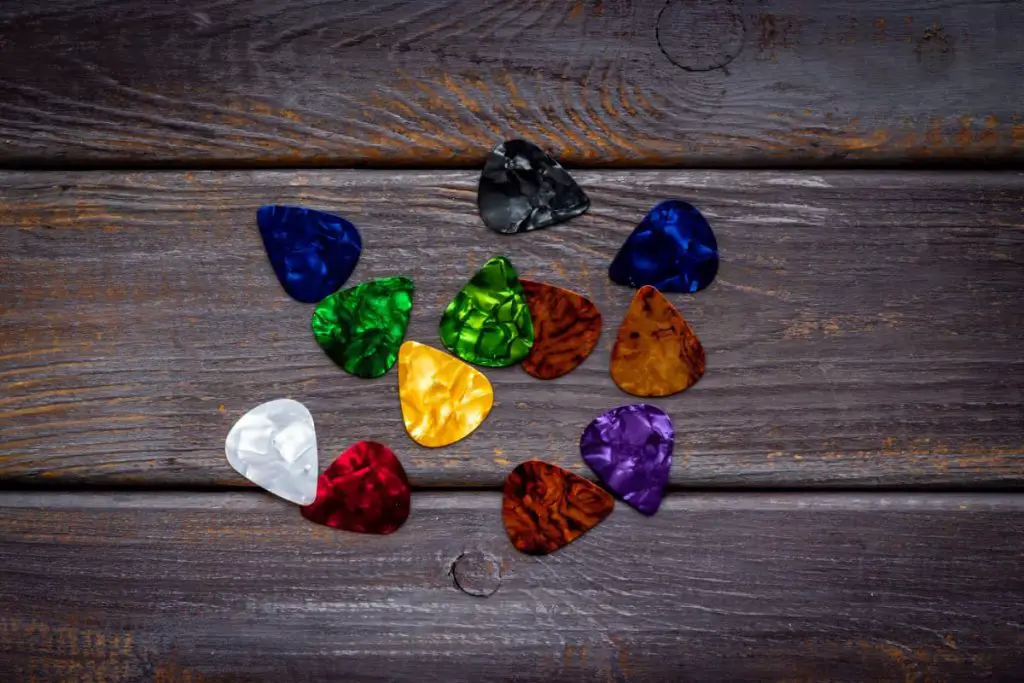
Pick Thickness
There are so many different picks to choose from that it can be difficult for someone just starting to play. Thinner picks are generally better for new guitarists because they are more forgiving if you hit the strings hard.
The easiest way to figure out what pick thickness is right for you is to buy a variety pack with several different kinds. Trying out different thicknesses to see what works best for you is an excellent way to start, and then you can move up in thickness as you get more comfortable.
Pick Material
It’s also crucial to consider what type of pick material will be easiest for you to play comfortably. A pick that is flat or has a smooth, shiny finish is probably not the best choice for a new musician since it’s much more likely to slip out of your hand while you are playing.
The best pick for a beginning guitar player will be one with a powdery finish or a ridged texture. These materials will be much easier to hold onto while learning how to strum correctly and will not fall out of your fingers as you begin to get faster in your playing.
Acetal is one of those materials that will work well for guitarists just getting the hang of playing with a pick. It has a gritty texture that will help you keep your grip while strumming, and you can use them for multiple playing styles.
Pick Shape
You can find a pick in just about any style you would like, but the shape of the pick plays a relatively significant role in how it works for you as a new musician.
The standard shape of pick, the triangle-style with a curved end, will be your best bet as a beginner. There are two types of the classic pick, one with a curved tip and one with a pointed tip.
The curved tip pick will be the best option for learning how to make basic strumming patterns. As you become more advanced in your playing and start doing solos, you may prefer the pointed tip, but to start, you’ll have the most success with a rounded tip.
Song Choices for Your Pick
As a beginner, you’ll want to start with two unique styles of picks: one to play strumming songs and one to play chord-picking songs.
Strumming songs are often done on the acoustic guitar and sound best while using a very light pick. The thin pick flows nicely across the strings as you strum and gives the guitar a rich sound.
On the other hand, chord-picking songs sound better when played with a slightly thicker pick. Picking at the individual chords means the output will be quieter than strumming all six strings. A pick with a greater thickness will help increase your playing volume.
The Advantages of Flatpicking Over Fingerstyle
Fingerstyle is synonymous with nylon-stringed or classical guitar, and musicians don’t often use this technique in steel-stringed guitars. Fingerstyle lends itself to solo play as it is polyphonic and incorporates bass, harmony, and melody independently.
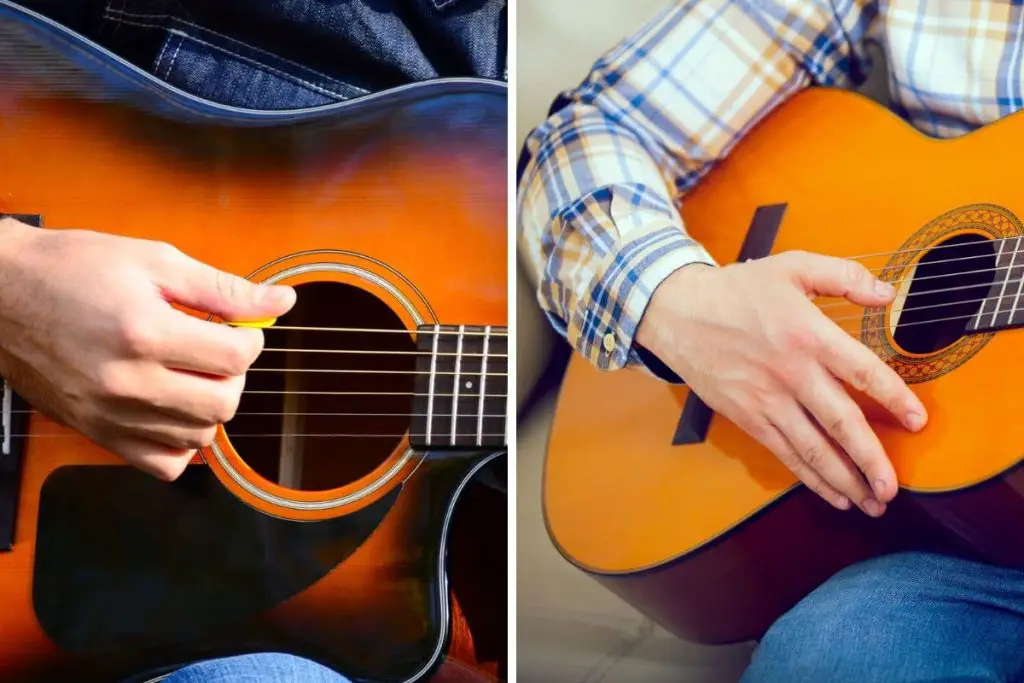
There are other instances when fingerstyle trumps flatpicking. When it comes to certain styles of music, such as country, blues, and folk, fingerstyle provides advantages that flatpicking can not. Essentially fingerstyle gives you the option of four picks at once, which lends itself to music styles such as folk music.
Folk music often requires you to use two notes simultaneously on two non-adjacent strings and percussive elements such as slap strums. Fingerstyle certainly lends itself to this style of playing more than flatpicking.
However, flatpicking is the better choice to start your playing properly unless you intend to devote your playing to entirely this style of play. You could always combine both playing styles once you have mastered the basics.
Final Thoughts
Ultimately, it will be in a beginner guitar player’s best interest to opt for flatpicking to learn their instrument. It will help immensely with your practice and set you on the right path toward becoming an expert guitar player.
👇😀👇NOTE👇😀👇
If you want to find out what my recommended guitar gear is, then here is what I recommend on Amazon:
- Fender Cutaway Acoustic-Electric Guitar Bundle (MY FAVORITE GUITAR)
- Snark SN-8 Super Tight All Instrument Tuner (Easiest Tuner I’ve Used😏)
- 6 String Acoustic Guitar Capo (Best CAPO for quick changes)
- Dunlop Max Grip 1.0mm Nylon Picks (Thick Guitar Pick So You Don’t Lose Grip!)
- Universal Guitar Stand (Cheap & Minimalist Guitar Stand I Recommend)
- Levy’s 2″ Wide Quick Adjust Guitar Strap (Best Guitar Strap For Any Level)
Related Posts:

